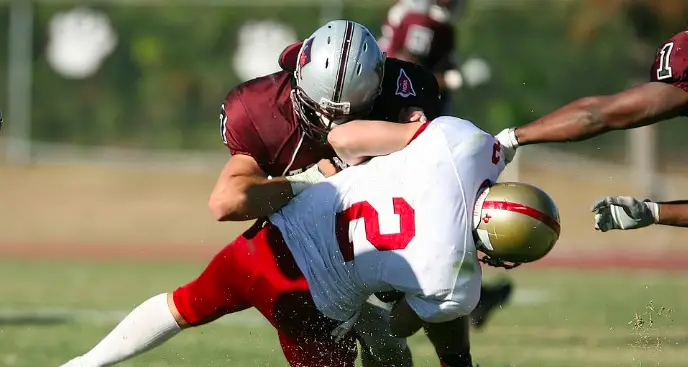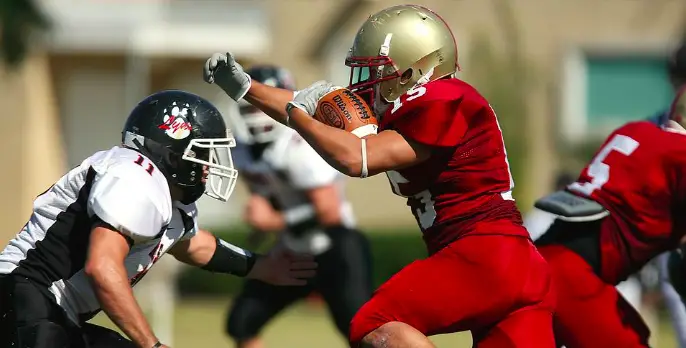In football, the term ATH means athlete and used to describe players that play multiple positions.
When a player has this designation out of high school it often means they want to be scouted by colleges for more than just one position.
Often times on high school football teams there will be a single-player that is significantly more athletic than the rest of the team. Since these players are so valuable they will often play on both sides of the ball.
These multiple positions can sometimes be too much to list for the player. So instead of listing a single position a team may state the player is an ATH meaning athlete.
Why Are Players Giving The ATH Designation?
Playing Out Of Position
One of the main reasons players are designated as an athlete is because they often play out of position in high school. The most common occurrence for the ATH designation is the quarterback position.
This is because oftentimes teams will simply put their best athlete in at quarterback. These ATH players often act as dual-threat quarterbacks often gaining yards on the ground.
The trouble is many of these athletes are attempting to play the quarterback position professionally or even in college. And since their passing is not usually at the collegiate level marking them down as a quarterback might mean they will not get any offers.
In these situations, a coach may opt to mark a player down as an athlete. This says to scouts that this player is playing quarterback but realistically can play many other positions as well.
It is more or less a sign to a scout to say evaluate this player for more than just the quarterback position.
Playing Too Many To Count
Another reason a player may be considered an ATH is that they simply play a ton of different positions. It is not entirely uncommon for a player to be a kicker, punter, quarterback, and off-ball linebacker for example.
This player is not going to play every snap. But they often have the skills to succeed at multiple positions on the team. When marking this players position down there is no point in limiting his position to one.
Instead, the coach may designate the player as an ATH to let scouts know he plays multiple positions. This increases the odds the player is scouted as he is effectively trying out for multiple roster spots.
Sizing Mismatch
A sad reality of the top college football programs is that players need to fit a certain size profile to play a position. This means that high school players that do not fit the bill will have to look for another position to play at the level.

For example, you cannot have a 5″7 160 pound linebacker player in division one football, no matter how well he played in his high school days.
For this reason, some coaches may opt to label their player as an athlete instead of using his high school position. This is because the coach and player know that his measurements will not get him the position he has already played the collegiate level.
This also works as a heads up to scouts to evaluate the player at other similar positions that may fit closer to his build.
What Position Do Most ATH Play
The most common position in high school that earns the ATH designation is quarterback. As we covered earlier these players often play out of position due to being the most athletically gifted player on the team.
But what position do these players end up playing when they get to the next level?
Running Back
The RB position is one of the most common positions to play as an ATH as it requires great athletic ability. It is very common for the running back to be the most athletic player on the team.

This is why many ATH tend to gravitate toward this position. These sorts of players are great with the ball in their hands which makes being a running back a great fit.
Wide Receiver
WR is another position that is often played by ATH’s. Again this is a very athletic position that requires a great deal of speed and coordination.
Additionally, wide receivers are paid quite well and are often the stars of a football team.
This leads many great athletes to switch to this position as it is one of the most lucrative to play. Additionally playing high school quarterback helps with playing this position as you know what is expected of the receivers.
Defensive End
One more position that you may not expect ATH’s to play is DE. In most cases, this occurs when a player is significantly bigger or stronger than the rest of his high school teammates for example.
Think of a player like Myles Garrett, in high school he played several positions due to his strength, size, and athletic ability. Once going to college Garrett picked a position in which he would have the most impact.
Since the defensive end position is one of the most important in the game many larger players take this route. Not to mention good pass rushers are typically one of the highest-paid positions in the league.
Examples of the ATH position in football
Deebo Samuel
Deebo Samuel is a football player for the San Fransisco 49ers and is a great example of the ath position in football.
Throughout his years in college Deebo primarily played wide receiver but took a few snaps at the running back position as well.
During these college games, NFL scouts took notice of how effective this player was with the ball in his hands.
When drafted into the NFL Deebo immediately became one of the best wide receivers on his team. In his rookie season, his coaches gave him a few carries at the running back position.
With his limited carries, Samuel had yards per carry average of 11.4 yards. This stat could not be matched by any other running back in the league.
By his third year in the league, Samuel was able to get 56 carries which he turned into 365 rushing yards.
During this same season, he was able to amass 1405 receiving yards as a wide receiver. This duality of playing both wide receiver and running back is exactly what the ATH position in football is all about.
Julian Edelman
Another great example of an ATH coming out college football is Julian Edelman. Most know Julian Edelman as the New England Patriots slot receiver who was one of Tom Brady’s favourite targets.
But before Edelman was in the NFL he was actually a college football quarterback. Coming out of college NFL scouts released that his arm strength and accuracy were not enough to allow him to succeed at the NFL level.
Despite this Edelman had athletic talent that could not be overlooked. Many teams considered Edelman an ATH but hadn’t quite decided how to use him.
At first, many NFL analysts believed that he may be used for a wildcat formation. Instead, Edelman started his NFL career as a punt returner.
Edelman was quickly able to get onto the field as a slot receiver following an injury to Wes Welker. Edelman showed he could perform effectively as a slot receiver due to his speed and agility.
By the end of his career, Edelman had one three Super Bowls leading his team in receiving yards in all three games.
This change of position from quarterback to punt returner to slot receiver is the exact sort of thing an ATH football player can do.

